Aiyanar Beach & Dive Resort, Anilao, PhilippinesContents of this Issue: Aiyanar Beach & Dive Resort, Anilao, Philippines Fiji, Molokai, Little Corn Island, St. Eustatius How You Can Purge Plastic from the Ocean Your Dive Boat Sinks Before You Get There Sharks are Not Pussycats as Shark Divers Discover The Etiquette of Tipping on Dive Trips: Part II Parents Sue PADI over the Death of Their 13-Year-Old Son Failing to Turn Your Tank On All the Way Is “Simply Stupid” The Potential of a Liveaboard Fire New Fire Safety Regulations Coming for US Liveaboards American Diver Dies in Red Sea Aggressor I Fire Those Underwater Photo Courses A DIN or a Yoke Regulator? It’s Time To Know The Difference Editorial Office: Ben Davison Publisher and Editor Undercurrent 3020 Bridgeway, Suite 102 Sausalito, CA 94965 only if you are a macro photographer from the November, 2019 issue of Undercurrent
Dear Fellow Diver, Frogfish are a rare sight in the Caribbean, and if you see one, it will usually be on a sponge of the same color and texture. I remember a St. Lucia dive where a guide pointed out a frogfish that was right before my eyes but matched its sponge exactly, so I never really saw it. Not so in Anilao, a two- to three-hour drive south from Manila, where frogfish are plentiful and can be easily seen in sharp contrast against mucky sand and gravel bottoms.
Small, unique critters are what Anilao diving is all about. Which is why you need to be a critter-loving photographer to enjoy Anilao fully. Don't go if you're looking for bigger creatures, because they are not there. Nearly all the divers -- mostly American, with a few from Europe, Australia, China, and South Korea -- were there with serious camera gear. It's all about your guide finding an interesting critter, then letting you spend all the time you want getting a good photo. My dives were typically no deeper than 50 feet, so dive times were routinely around 70 minutes, making four dives a day easy (plus a night dive when I wanted). I wasn't asked to do a checkout dive and never heard a post-dive roll call, but with two divers per guide, I felt well looked after. Given the longer dives, the number of dives, and the early-May water temperatures (75º-81ºF), most divers wore 5-mm wetsuits. I didn't need a hood, but I needed booties to walk the rocky beach to board one of Aiyanar's bangkas, the traditional, narrow-beamed boats with a shallow draft and outriggers on both sides. Getting on and off a bangka from the beach was challenging because I had to walk up an eight-inch-wide wobbly wooden plank with only the boatman's hand to grasp. Divers stumbled occasionally, but it was more embarrassing than dangerous to fall into the water. I was relieved when occasionally I was assigned to a more traditional dive boat that I could board from the dock. The hard-working boatmen not only carried our tanks and set up our gear, but also they hauled our heavy, bulky camera gear so I could manage the plank. (While I heard there was shore diving, I never saw anyone do it). Typical of Anilao's resorts, Aiyanar is built on the side of a steep hill that plunges to water's edge. From my room near the top, I counted 33 steep steps down to the dining room, another 16 steps down to the dive deck and camera room, then 25 steep, irregular steps to the beach and dock. That's 74 steps. It was easy to stumble, and a woman in my traveling group sprained an ankle to prove it. I found the safest way to manage the steps was to look down the entire time and ignore conversing with my buddy so I could focus. Clearly, some divers should skip this place because of the steps or at least try to tie down a room on the level closest to the dining room. My room was plain but adequate, just a double bed, TV and a small desk and chair, and a bathroom with sufficient hot water. The air conditioning worked well, and the charming balcony had two chairs and a bay view, but with humid daytime temperatures hitting the low 90s, I never sat outside. I only used the drying rack on the balcony during the day, because when I left clothes out overnight, the humidity left them even soggier in the morning.
On the same level as the camera room is the gear room, really a series of open-air racks under a roof where divers had plenty of space to store wetsuits and other gear. Before boarding the boat, I placed my camera in my assigned tub, and a boatman or guide carried it to the boat, then after the dive, deposited it back into my tub carried it ashore. Indeed, they take good care of photographers. People claim Anilao has more species of nudibranchs than anywhere else on the planet, and I believe them. Those I saw on all dives were brilliantly colored, striped and spotted, and ranged from four inches long down to a tiny quarter-inch. Unlike most marine creatures, where for shooters the name of the game is to get the critter's eyes into sharp focus, nudis do not have eyes. Thus, the challenge is to get their rhinophores, the horn-like appendages, into focus. Here's where diving skills became important -- the only way I could get a good shot was to keep my body in position while holding the camera perfectly aligned with the rhinophores for at least a few minutes. It took both practice and patience, but the bursting color of abundant nudibranchs made it worthwhile.
After dinner, most divers would review each other's shots, offering advice if asked. Nobody left the resort at night, because the surrounding area is impoverished, with nothing to offer a tourist. Walking down the steps from the resort to the boat, I often passed entire families selling beads -- a sad sight; worse, I once saw a completely naked two-year-old boy holding up beads for sale. We divers were in our wetsuits and had no cash, so one day, I made it a point to bring some pesos to buy beads.
When we arrived at some dive sites, they were crowded, with half-a-dozen bangkas from different resorts arriving simultaneously. The currents, which sometimes reached a couple of knots, meant divers could spread out, and the bangkas moved unpredictably to pick them up. I was new at using a surface marker buoy, so the first time I used one, at Arthur's Point, I gave it one full breath, and up it went, but it flopped at the surface. For my next dive, I vowed not to have a floppy SMB (a male-ego thing, no doubt), so I gave it one full breath, held on while I took a breath from my regulator, then gave it another breath. Uh-oh . . . holding onto the SMB made me float to the surface before I wanted and without a safety stop. There was no problem, but keep in mind that the nearest decompression chamber is in Manila. The time I didn't have my SMB, I surfaced right below a bangka's outrigger and held on while looking for my boat. Luckily, it was an easy surface swim after the alert boatman quickly spotted me. It seemed the boat ladders had been built for small feet, so before boarding I removed my gear in the water, then handed it to a boatman. Those guys may only be a tad over five feet, but they're all muscle, and what's more, they do it with a big smile.
PS: I should add that sometimes I read news reports of terrorist attacks in the Philippines, but Anilao is on the main island of Luzon, while attacks typically happen 500 miles south on other islands. To enter Aiyanar's grounds, a well-armed security guard opened a six-foot-high steel gate, but I never felt any threat. To enter the Marriott near Manila's airport, I had to pass through a metal detector, and my luggage was X-rayed. The X-ray picked up a small dive knife on another diver's BCD, and he had to leave it with the concierge until checkout. On my return to the airport, I tipped a guy in a bright-colored shirt to take me and my luggage to the head of the long security line. -- G.P.T. Our undercover diver's bio: Certified in 1983, I am a PADI Advanced Open Water diver who has made more than 1,000 dives at resorts and on liveaboards around the Caribbean, Indonesia, Australia, California, and Hawaii. Aiyanar Resort pool area 5 For the past decade, I've been serious about underwater photography, and I've taken many organized photo excursions, in which instruction is the important feature of the trip.
|

I want to get all the stories! Tell me how I can become an Undercurrent Online Member and get online access to all the articles of Undercurrent as well as thousands of first hand reports on dive operations world-wide
| Home | Online Members Area | My Account |
Login
|
Join
|
| Travel Index |
Dive Resort & Liveaboard Reviews
|
Featured Reports
|
Recent
Issues
|
Back Issues
|
|
Dive Gear
Index
|
Health/Safety Index
|
Environment & Misc.
Index
|
Seasonal Planner
|
Blogs
|
Free Articles
|
Book Picks
|
News
|
|
Special Offers
|
RSS
|
FAQ
|
About Us
|
Contact Us
|
Links
|
3020 Bridgeway, Ste 102, Sausalito, Ca 94965
All rights reserved.

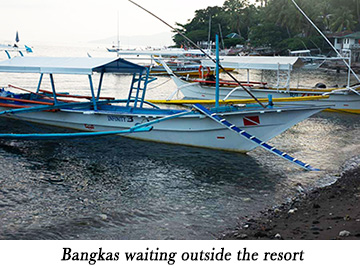 On my first dive, at Secret Bay, I asked one of my dive guides if he could find me a frogfish. (We had one guide for two divers, and the resort never has more than four divers per guide.) After backrolling in, I knew this wouldn't be Caribbean-style diving -- visibility was 25 feet, and all I saw was sand and gravel with discarded bottles, tires, and other trash, but that's where my skilled guide came in -- he found a frogfish within five minutes, plus other unique photo opportunities in this underwater desert. I was impressed with Aiyanar's Filipino dive guides -- while they only spoke passable English, they worked hard to find us critters to photograph and were usually successful. (As I've come to expect in Asian countries, many of the dive leaders smoked before and between dives, but here they vaped, which, I suppose, is a much less likely way to start an unexpected fire).
On my first dive, at Secret Bay, I asked one of my dive guides if he could find me a frogfish. (We had one guide for two divers, and the resort never has more than four divers per guide.) After backrolling in, I knew this wouldn't be Caribbean-style diving -- visibility was 25 feet, and all I saw was sand and gravel with discarded bottles, tires, and other trash, but that's where my skilled guide came in -- he found a frogfish within five minutes, plus other unique photo opportunities in this underwater desert. I was impressed with Aiyanar's Filipino dive guides -- while they only spoke passable English, they worked hard to find us critters to photograph and were usually successful. (As I've come to expect in Asian countries, many of the dive leaders smoked before and between dives, but here they vaped, which, I suppose, is a much less likely way to start an unexpected fire).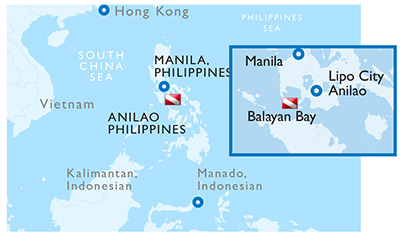 After managing those 49 unstable steps to the camera room, the payoff was entering a large air-conditioned room with good-sized photo stations and plenty of outlets. However, a user carelessly blowing water off his gear with the compressed air hose could easily blow water into someone's delicate gear, like a camera with the lens off. I say keep the hoses outside the camera room. And one unusual touch: private dunk tanks -- numbered plastic tubs lined up and filled with fresh water right outside the camera room.
After managing those 49 unstable steps to the camera room, the payoff was entering a large air-conditioned room with good-sized photo stations and plenty of outlets. However, a user carelessly blowing water off his gear with the compressed air hose could easily blow water into someone's delicate gear, like a camera with the lens off. I say keep the hoses outside the camera room. And one unusual touch: private dunk tanks -- numbered plastic tubs lined up and filled with fresh water right outside the camera room.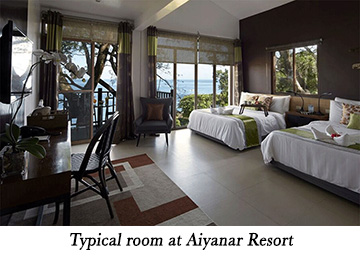 Other colorful critters I caught on camera were pipefish, Bobbitt worms
(which did indeed get their name from Lorena Bobbitt, who, in 1993, cut off her
carousing husband's penis with a knife while he slept -- look it up), the aptly
named flamboyant cuttlefish, and rhinopias -- a
unique scorpionfish. Lemon gobies hung out in beer
bottles, and, with a little patience on my part,
they came to the bottle's mouth to look right at
me. The dive guides told me that the fatally venomous
blue-ringed octopus is actually docile and
easy to approach to within inches for photos. So,
at Bubble's Point, I approached a six-inch blue
ring cautiously, then after a few minutes observing
it from a few feet away, I felt safe enough
to approach within six inches. However, I did this
solo -- I didn't want another diver inadvertently
disturbing it and causing it to, say, kill me. And,
I got my shots.
Other colorful critters I caught on camera were pipefish, Bobbitt worms
(which did indeed get their name from Lorena Bobbitt, who, in 1993, cut off her
carousing husband's penis with a knife while he slept -- look it up), the aptly
named flamboyant cuttlefish, and rhinopias -- a
unique scorpionfish. Lemon gobies hung out in beer
bottles, and, with a little patience on my part,
they came to the bottle's mouth to look right at
me. The dive guides told me that the fatally venomous
blue-ringed octopus is actually docile and
easy to approach to within inches for photos. So,
at Bubble's Point, I approached a six-inch blue
ring cautiously, then after a few minutes observing
it from a few feet away, I felt safe enough
to approach within six inches. However, I did this
solo -- I didn't want another diver inadvertently
disturbing it and causing it to, say, kill me. And,
I got my shots.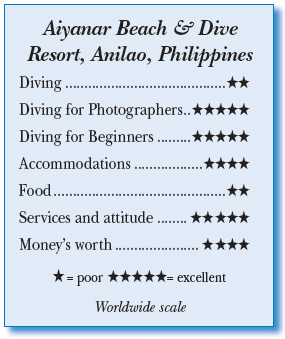 Aiyanar's always-smiling staff seemed genuinely pleased to help guests however
they could. The food servers, all students attending hotel school, were serious
about providing full service in the open-air dining room (with lovely views of the
bay). Breakfast didn't begin till 7 a.m., but early risers who used the dining
area for Wi-Fi (not available in the rooms) could request a French press coffee pot. Then the kitchen served eggs, bacon, sausage, pancakes and French toast, and chefs happily prepared omelets. Meat, fish, and pasta were served at lunch and dinner, but the meat was often so fatty that I spent half my time cutting away gristle to get a decent bite. They occasionally served chicken, but the pieces were small and irregular, and I never came across a piece that resembled a thigh or breast. And the vegetables? On par with the meat and chicken; rice is a staple, served in abundance at both lunch and dinner, but the only seasoning for it was the sauce from the sub-standard meat or fish; No American-style burgers or pizza. Meals were buffet-style, but servers brought post-dinner desserts to my table with panache. The water wasn't potable, so each room got a liter-bottle that the housekeepers refilled during their daily cleaning. I could also refill my bottle in the dining room, where a small bar served wine, beer, and spirits at modest prices.
Aiyanar's always-smiling staff seemed genuinely pleased to help guests however
they could. The food servers, all students attending hotel school, were serious
about providing full service in the open-air dining room (with lovely views of the
bay). Breakfast didn't begin till 7 a.m., but early risers who used the dining
area for Wi-Fi (not available in the rooms) could request a French press coffee pot. Then the kitchen served eggs, bacon, sausage, pancakes and French toast, and chefs happily prepared omelets. Meat, fish, and pasta were served at lunch and dinner, but the meat was often so fatty that I spent half my time cutting away gristle to get a decent bite. They occasionally served chicken, but the pieces were small and irregular, and I never came across a piece that resembled a thigh or breast. And the vegetables? On par with the meat and chicken; rice is a staple, served in abundance at both lunch and dinner, but the only seasoning for it was the sauce from the sub-standard meat or fish; No American-style burgers or pizza. Meals were buffet-style, but servers brought post-dinner desserts to my table with panache. The water wasn't potable, so each room got a liter-bottle that the housekeepers refilled during their daily cleaning. I could also refill my bottle in the dining room, where a small bar served wine, beer, and spirits at modest prices.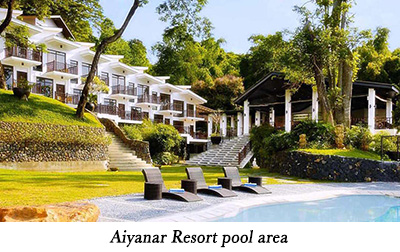 Indeed, Anilao is paradise for muck divers and macro photographers. While there aren't as many creatures as at top-ranked Lembeh Strait, there's at least less garbage in the water, and you'll still get some fantastic shots. Just practice your dive skills beforehand so you can keep still enough to focus on those nudis.
Indeed, Anilao is paradise for muck divers and macro photographers. While there aren't as many creatures as at top-ranked Lembeh Strait, there's at least less garbage in the water, and you'll still get some fantastic shots. Just practice your dive skills beforehand so you can keep still enough to focus on those nudis. Diver's Compass: My seven-night stay at Aiyanar cost $1,423 per person, double occupancy, and included room, three meals per day, 22 boat dives with nitrox and van transfers to and from the airport . . . The 80 cu.-ft. aluminum tanks with standard A-clamp valves were more than adequate for this dive profile . . . Aiyanar has a small gift shop, but other than alcohol, there is really no other opportunity to spend money because Anilao lacks bars, restaurants and land excursions . . . Philippine Airlines has the only direct flight to Manila (from LAX), but I was told few people choose it due to the airline's reputation for using older aircraft and changing planes and times at the last minute . . . I stayed at the Manila Marriott for $150/night; next door, the Belmont Hotel is fine and reasonably priced . . . Websites: Aiyanar Beach & Dive Resort -
Diver's Compass: My seven-night stay at Aiyanar cost $1,423 per person, double occupancy, and included room, three meals per day, 22 boat dives with nitrox and van transfers to and from the airport . . . The 80 cu.-ft. aluminum tanks with standard A-clamp valves were more than adequate for this dive profile . . . Aiyanar has a small gift shop, but other than alcohol, there is really no other opportunity to spend money because Anilao lacks bars, restaurants and land excursions . . . Philippine Airlines has the only direct flight to Manila (from LAX), but I was told few people choose it due to the airline's reputation for using older aircraft and changing planes and times at the last minute . . . I stayed at the Manila Marriott for $150/night; next door, the Belmont Hotel is fine and reasonably priced . . . Websites: Aiyanar Beach & Dive Resort - 